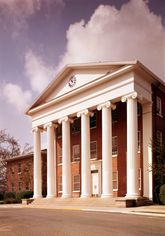University of Mississippi
| University of Mississippi (Ole Miss) |
|
|---|---|
 University of Mississippi logo |
|
| Motto | Pro scientia et sapientia |
| Motto in English | On behalf of knowledge and wisdom |
| Established | 1848 |
| Type | Public, Co-ed |
| Endowment | $369.9 million[1] |
| Chancellor | Dr. Daniel W. Jones |
| Academic staff | 729[2] |
| Students | 18,344[3] |
| Location | Oxford, Mississippi |
| Campus | Rural 1,000+ acres |
| Sports teams | Rebels |
| Colors | Harvard Crimson and Yale Blue (adopted in 1893)[4] |
| Mascot | (Change: Pending) |
| Website | www.olemiss.edu |
 |
|
The University of Mississippi, also known as Ole Miss, is a public, coeducational research university located in Oxford, Mississippi. Founded in 1848, the school is composed of the main campus in Oxford, four branch campuses located in Booneville, Grenada, Tupelo, and Southaven as well as the University of Mississippi Medical Center in Jackson. It also operates the University of Mississippi Field Station in Abbeville. Additionally, it is both a sea-grant and space-grant institute. Sixty-nine percent of undergraduates are from Mississippi, and nineteen percent of all students are minorities. International students come from sixty-six nations.
Contents |
History
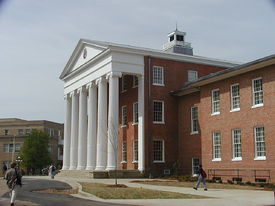
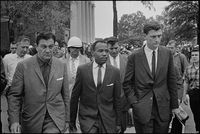

The University got its nickname "Ole Miss" via a contest in 1897. That same year, the student yearbook was being published for the first time. As a way to find a name for the book, a contest was held to solicit suggestions from the student body. Elma Meek, a student at the time, submitted the winning entry of Ole Miss. This sobriquet was chosen not only for the yearbook, but also became the name by which the University is now known.[5]
The Lyceum, built in 1848, is the oldest building on campus. In its first year, it housed all of the classrooms and faculty offices of the university. The Lyceum is now the home of the university's administration offices. The columned facade of the Lyceum is represented on the official crest of the university, along with the date of establishment.
The School of Medicine, which was originally located at the eastern gate of the campus, was used as a hospital during the Civil War for both Union and Confederate soldiers, especially those who were wounded at the battle of Shiloh. The School of Medicine then teaching the first two years of pre-clinical education and granting medical certificates was moved to the western edge of campus into Billy S Guyton Hall in 1934. After the medical school moved to the new University Hospital in Jackson, Guyton Hall housed the ROTC units. After a complete renovation in 2005 it currently houses the School of Education. The School of Medicine is now located in Jackson, Mississippi. The original building, was renamed Brady Hall in honor of a former head nurse, this building served as a dormitory for male students and then as the home of the Music Department in its last years before being condemned in the early 1970s, was replaced by a new Chemistry building in the mid 1970s. Soldiers who died in the campus hospital were buried in a mass grave located at the northeast corner of the Coliseum which was built nearly 100 years later as a venue for concerts and basketball games.
With the outbreak of the Civil War, classes were interrupted when the entire student body and many faculty from Ole Miss enlisted in the Confederate army. Their company, Company A, 11th Mississippi Infantry, was nicknamed the University Grays, and suffered a 100% casualty rate during the Civil War. A great number of those casualties occurred during Pickett's Charge at the Battle of Gettysburg on July 3, 1863, when the University Grays made the deepest encroachment into Union territory. Some of the soldiers actually crossed the Union defensive fortification wall, only to be killed, wounded or captured. On the very next day, July 4, Confederate forces surrendered at Vicksburg, Mississippi; the two battles together are commonly viewed as the turning point in the war. When Ole Miss re-opened, only one member of the University Greys was able to visit the university to address the student body. The university was led, during the post-war period, by former Confederate general A.P. Stewart, a Rogersville, Tennessee native, who was President from 1874-1886.
During the 1930s, an attempt by Mississippi Governor Theodore G. Bilbo to move the University of Mississippi to Jackson, was prevented by then Chancellor Alfred Hume by giving Mississippi legislators a grand tour of Ole Miss and the surrounding city of Oxford. It so impressed the legislators that the move was defeated.
Desegregation
Desegregation came to Ole Miss in the early 1960s with the activities of United States Air Force veteran James Meredith from Kosciusko, Mississippi. Even Meredith's initial efforts required great courage. All involved knew how violently Dr. William David McCain and the white political establishment of Mississippi had recently reacted to similar efforts by Clyde Kennard to enroll at Mississippi Southern College (now the University of Southern Mississippi).[6][7][8][9]
Meredith won a lawsuit that allowed him admission to the University of Mississippi in September 1962. He attempted to enter campus on September 20, September 25, and again on September 26[10], only to be blocked by Mississippi Governor Ross R. Barnett, who proclaimed that "...No school in our state will be integrated while I am your Governor. I shall do everything in my power to prevent integration in our schools."[11]
After the United States Court of Appeals for the Fifth Circuit held both Barnett and Lieutenant Governor Paul B. Johnson, Jr. in contempt with fines of more than $10,000 for each day they refused to allow Meredith to enroll[12], Meredith, escorted by a force of U.S. Marshals, entered the campus on September 30, 1962[13].
The enrollment of Meredith led to an anti-desegregation riot. Thousands of students, citizens from the surrounding area and many from out of state, many armed, were involved. There was a sense among a certain class of white Mississippi males that this was their battle against 'Catholic, Communist, Northern' intervention in Mississippi white people's business. The protesters swarmed the campus in a violent effort to prevent Meredith's enrollment, and thus save a part of the segregationist policies of Mississippi at the time.
Two people died during the riot. Meredith, thanks to the protection afforded by federal marshals, was able to enroll and attend his first class on October 2. Following the riot, elements of an Army National Guard division were stationed in Oxford to prevent future similar violence. While most Ole Miss students did not riot prior to his official enrollment in the university, many harassed Meredith during his first two semesters on campus.
According to first person accounts chronicled in Nadine Cohodas's book The Band Played Dixie, students living in Meredith's dorm bounced basketballs on the floor just above his room through all hours of the night. When Meredith walked into the cafeteria for meals, the students eating would all turn their backs. If Meredith sat at a table with other students, all of whom were white, the students would immediately get up and go to another table.
The site of these riots, known as the Lyceum-The Circle Historic District, was designated as a National Historic Landmark by the United States Secretary of the Interior on October 7, 2008.[14] The district includes:
- The Lyceum
- The Circle
- Croft Institute for International Studies, also known as the "Y" Building
- Old Chemistry Building
- Carrier Hall
- Shoemaker Hall
- Ventress Hall
- Bryant Hall
- Peabody Hall
Additionally, on April 14, 2010, the University campus was declared a National Historic Site by the Society of Professional Journalists to honor reporters who covered the 1962 riot. One of the two people killed during the riot was a French reporter named Paul Guihard.[15]
Presidential debate
The University was chosen to host the first presidential debate of 2008, which was held September 26, 2008. This was the first ever presidential debate to be held in Mississippi.[16][17]
Academics
Divisions of the University
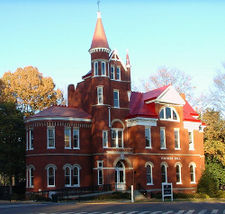
The degree-granting divisions located at the Main Campus:
- School of Accountancy
- School of Applied Sciences
- School of Business Administration
- School of Education
- School of Engineering
- College of Liberal Arts
- Graduate School
- School of Law
- School of Pharmacy
- School of Journalism and New Media

The colleges at the University of Mississippi Medical Center campus in Jackson:
- School of Dentistry
- School of Health Related Professions
- School of Nursing (with a satellite unit at the main campus in Oxford)
- School of Medicine
- School of Graduate Studies in the Health Sciences
University of Mississippi Medical Center surgeons, lead by Dr. James Hardy, performed the world's first human lung transplant, in 1963, and the world's first human heart transplant, in 1964. The heart of a chimpanzee - man's closest genetic relation - was used for the heart transplant.[18][19]
The University of Mississippi Field Station located in Abbeville is a natural laboratory used to study, research and teach about sustainable freshwater ecosystems.
Since 1968, the school operates the only legal marijuana farm and production facility in the United States. The National Institute on Drug Abuse (NIDA) contracts to the university the production of cannabis for the use in approved research studies on the plant as well as for distribution to the seven surviving medical cannabis patients grandfathered into the Compassionate Investigational New Drug program (established in 1978 and canceled in 1991).[20]
The university houses one of the largest blues music archives in the United States. Some of the contributions to the collection were donated by BB King who donated his entire personal record collection. The Mamie and Ellis Nassour Arts & Entertainment Collection, highlighted by a wealth of theater and film scripts, photographs and memorabilia, was dedicated in September, 2005. The archive includes the first ever commercial blues recording, a song called "Crazy Blues" recorded by Mamie Smith in 1920.[21]
Statistics
- The University of Mississippi is among the top 30 public institutions with the largest endowments per student.
- The University of Mississippi has produced 25 Rhodes Scholars and has also produced six Fulbright, one Marshall, six Truman, and eight Goldwater Scholars since 1998.
- The School of Law is the fourth-oldest state-supported law school in the nation.
- The School of Pharmacy ranks 20th in the nation among schools of pharmacy for funding from the National Institutes of Health and 2nd among pharmacy schools for total federal funding.
- The University of Mississippi's School of Accountancy is ranked 15th in the nation.
- The University of Mississippi's Sally McDonnell Barksdale Honors College (founded and supported by Jim Barksdale in honor of his late wife) was ranked one of the top 3 honors colleges in the nation by Reader's Digest.[22]
- The University of Mississippi Medical Center was recently granted a secondary nursing program, which is a program for first semester nursing students who already have a degree. It is the only school in Mississippi with this type of grant.
- In 2007, the average ACT score of entering freshmen at the University of Mississippi (excluding the UM Medical Center) was 22.9.[23]
- In 2010, the The Princeton Review named it the nation's 5th Top Party University.
Student life
Student media
- The Daily Mississippian is the student-published newspaper of The University, established in 1937. Although The Daily Mississippian (DM) is located on the Ole Miss campus, it is operated largely as an independent newspaper run by students. The DM is the only college newspaper in Mississippi that is published five times a week. The editorial staff consists of approximately 15 students, along with a staff of 15-20 writers and 5 photographers, though these numbers vary from year to year and semester to semester. There is also an entire department devoted entirely to advertising sales and production. With a circulation of 15,000, it is one of the largest college newspapers in the country.[24]
- The Ole Miss student yearbook is a 416-page color book produced by students with faculty advice. It has won various awards including the Gold Crown.[25]
- WUMS-FM 92.1 Rebel Radio, operated by students, is a 3,000-watt FCC-commercially licensed radio station.
- NewsWatch is the only student-produced, live newscast in the state of Mississippi. Broadcast through the Metrocast cable company, it is live at 5:30 Monday-Friday.[26]
These five publications are a part of the S. Gale Denley Student Media Center at Ole Miss. Current director of student media is Patricia Thompson.
Athletics
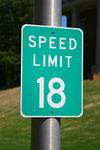
Archie Manning's uniform number, 18, has become the official speed limit of the Oxford campus.
Student housing
Approximately 4,386 students live on campus in the fourteen residence halls available. All freshmen (students with less than 30 credit hours) are required to live in campus housing their first year unless they meet certain commuter guidelines.[27] The Department of Student Housing and Residence Life is an auxiliary, meaning that it is self-supporting and does not receive appropriations from state funds. All rent received from students pays for housing functions such as utilities, staff salaries, furniture, supplies, repairs, renovations and new buildings.[28] Most of the residence staff members are students, including day-to-day management, conduct board members and maintenance personnel.[29] Upon acceptance to The University of Mississippi, a housing application is submitted with a processing fee.[29] On Campus Housing cost ranges from $1730 to over $5000(the highest price being that of the new residential college) per semester depending on the occupancy and suite type.[29] Students (with more than 30 credit hours) have the option to live off campus in unaffiliated housing.[29]
Greek life
Despite the relatively small number of Greek-letter organizations on campus, many students participate in Greek life at Ole Miss. The tradition of Greek life on the Oxford campus is a deep-seated one. In fact, the first fraternity founded in the South was the W.W.W. (or Rainbow Society), founded at Ole Miss in 1848, which went on to charter other chapters across the South. The fraternity merged with Delta Tau Delta in 1886.[30] Delta Gamma national sorority was founded in 1873 at the Lewis School for Girls in nearby Oxford. Today, sorority chapters are very large, with many boasting of around 250 active members. Recruitment is fiercely competitive and potential sorority members are encouraged to secure personal recommendations from Ole Miss sorority alumnae in order to increase the chances of receiving an invitation to join one of the 9 NPC sororities on campus.
|
|
Associated Student Body
The Associated Student Body (ASB) is the Ole Miss student government organization.
Noteworthy alumni
- Novelist William Faulkner attended.
- Best-selling legal thriller writer John Grisham received his Juris Doctor degree at Ole Miss Law. [31],
- Charlie's Angel Kate Jackson and long-time "As the World Turns" star Anthony Herrera attended the university.
- Former NFL quarterback Archie Manning attended Ole Miss and played football for the Rebels. He met his future wife Delta Gamma Olivia Manning at Ole Miss.
- Archie Manning's youngest son, Eli Manning, also played quarterback at Ole Miss and is now the starting quarterback for the New York Giants.
- The University has produced three Miss Americas: Susan Akin (1986 and a member of Pi Beta Phi), Mary Ann Mobley and Lynda Lee Mead (1959 and 1960 roommates and both members of Chi Omega).
- Baltimore Ravens Left Tackle Michael Oher - Drafted in the first round of the 2009 NFL draft. Also see The Blind Side (film)
Noteworthy alumni in fiction
- Dr. Leonard "Bones" McCoy, a character in Star Trek
- Suzanne Sugarbaker, a character in Designing Women (she was a member of Pi Beta Phi sorority)
- Ellen Roark, a character played by Sandra Bullock in the 1996 movie A Time to Kill, based on the novel by real alumnus John Grisham
- William Faulkner's estate, Rowan Oak, is owned by the university. His Nobel Prize for Literature is held in Archives and Special Collections at J. D. Williams Library on the Ole Miss campus. The town of Oxford surrounds the campus which is located in Lafayette County and inspired Faulkner and his imaginary town of Jefferson, the county seat of Yoknapatawpha County
See also
- Mississippi Teacher Corps – based at the university
- University of Mississippi School of Law
References
- ↑ As of June 30, 2009. "U.S. and Canadian Institutions Listed by Fiscal Year 2009 Endowment Market Value and Percentage Change in Endowment Market Value from FY 2008 to FY 2009" (PDF). 2009 NACUBO-Commonfund Study of Endowments. National Association of College and University Business Officers. http://www.nacubo.org/Documents/research/2009_NCSE_Public_Tables_Endowment_Market_Values.pdf. Retrieved March 12, 2010.
- ↑ OLE MISS FACTS 2007-08
- ↑ Profile2009.pmd
- ↑ Ole Miss Traditions
- ↑ The Ole Miss Student Yearbook
- ↑ The Funding of Scientific Racism: Wickliffe Draper and the Pioneer Fund by William H. Tucker, University of Illinois Press (May 30, 2007), pp 165-66.
- ↑ Neo-Confederacy: A Critical Introduction, by Euan Hague (Editor), Heidi Beirich (Editor), Edward H. Sebesta (Editor), University of Texas Press (December 1, 2008) pp. 284-85
- ↑ http://www.splcenter.org/intel/intelreport/article.jsp?aid=135
- ↑ Medgar Evers by Jennie Brown, Holloway House Publishing, 1994, pp. 128-132.
- ↑ http://www.jfklibrary.org/meredith/chron_main.html
- ↑ http://www.jfklibrary.org/NR/rdonlyres/A6EC14C6-ADAA-4F4D-8D92-A56180C26AD0/43850/BarnettRoss_oralhistory.pdf
- ↑ "Ross Barnett, Segregationist, Dies; Governor of Mississippi in 1960's". The New York Times. November 7, 1987. http://www.nytimes.com/1987/11/07/obituaries/ross-barnett-segregationist-dies-governor-of-mississippi-in-1960-s.html?sec=&spon=&pagewanted=all. Retrieved May 27, 2010.
- ↑ http://www.eotu.uiuc.edu/pedagogy/grogers/GRP/Meredith_1.htm
- ↑ Gene Ford and Susan Cianci Salvatore (2007-01-23). National Historic Landmark Nomination: Lyceum. National Park Service. http://www.nps.gov/history/nhl/Fall07Nominations/Lyceum.pdf.
- ↑ Jerry Mitchell (April 14, 2010). "Ole Miss declared National Historic Site". The Clarion-Ledger. http://blogs.clarionledger.com/jmitchell/2010/04/14/ole-miss-declared-national-historic-site/. Retrieved April 14, 2010. Archived at WebCite
- ↑ The Clarion-Ledger: University lands first of 3 debates; Accessed November 20, 2007
- ↑ 2008 Presidential Debate | The University of Mississippi - Official Home Page
- ↑ "History of Lung Transplantation". Emory University. April 12, 2005. http://www.emoryhealthcare.org/transplant-center/lung-transplant/history.html. Retrieved 2009-09-08.
- ↑ Time Magazine: Surgery: First Heart Transplant - January 31, 1964
- ↑ CNN: Government runs nation's only legal pot garden - May 18, 2009
- ↑ Billboard Magazine: Internet Site Shines Light On Archival Blues Recordings - June 9, 2001
- ↑ Best Honors College: Sally McDonnell Barksdale Honors College
- ↑ IHL Fast Facts
- ↑ The DM
- ↑ The Ole Miss
- ↑ NewsWatch
- ↑ Student Housing and Residence Life — The University of Mississippi
- ↑ Student Housing and Residence Life — The University of Mississippi
- ↑ 29.0 29.1 29.2 29.3 Student Housing and Residence Life — The University of Mississippi
- ↑ The New York Times: Two secret societies united, Delta Tau Delta and the Rainbow Society join hands; Published March 28, 1885; Accessed December 08, 2007
- ↑ John Grisham » Bio
External links
|
||||||||||||||||||||||||||
|
|||||
|
||||||||
|
||||||||
